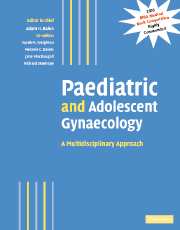Book contents
- Frontmatter
- Contents
- Contributors
- Preface
- Part I Normal development
- Part II Management of developmental abnormalities of the genital tract
- Part III Management of specific disorders
- 18 Disorders of growth and puberty
- 19 Turner's syndrome
- 20 Androgen insensitivity syndromes
- 21 Rokitansky syndrome and other Müllerian anomalies
- 22 The XY female
- 23 The gynaecology of the major genitourinary anomalies
- 24 Congenital adrenal hyperplasia
- 25 Long-term sequelae of genital surgery
- 26 Amenorrhoea
- 27 The polycystic ovary syndrome and adolescent women
- 28 Menstrual disorders in adolescent girls
- 29 Pelvic pain, ovarian cysts and endometriosis in adolescent girls
- 30 Premature ovarian failure and ovarian ageing
- 31 Gynaecological cancers in childhood
- 32 Late reproductive sequelae of treatment for childhood cancer
- 33 Preservation of fertility before cancer therapy
- 34 The management of infertility with surrogacy and egg donation
- 35 Dermatological conditions of the female genitalia
- 36 Vaginal discharge
- 37 Psychological gender development in individuals born with ambiguous genitalia
- 38 Eating disorders in adolescence
- 39 Nutritional amenorrhoea: long-term sequelae
- 40 How to set up a service: how to teach and train
- Index
- Plate section
- References
31 - Gynaecological cancers in childhood
from Part III - Management of specific disorders
Published online by Cambridge University Press: 04 May 2010
- Frontmatter
- Contents
- Contributors
- Preface
- Part I Normal development
- Part II Management of developmental abnormalities of the genital tract
- Part III Management of specific disorders
- 18 Disorders of growth and puberty
- 19 Turner's syndrome
- 20 Androgen insensitivity syndromes
- 21 Rokitansky syndrome and other Müllerian anomalies
- 22 The XY female
- 23 The gynaecology of the major genitourinary anomalies
- 24 Congenital adrenal hyperplasia
- 25 Long-term sequelae of genital surgery
- 26 Amenorrhoea
- 27 The polycystic ovary syndrome and adolescent women
- 28 Menstrual disorders in adolescent girls
- 29 Pelvic pain, ovarian cysts and endometriosis in adolescent girls
- 30 Premature ovarian failure and ovarian ageing
- 31 Gynaecological cancers in childhood
- 32 Late reproductive sequelae of treatment for childhood cancer
- 33 Preservation of fertility before cancer therapy
- 34 The management of infertility with surrogacy and egg donation
- 35 Dermatological conditions of the female genitalia
- 36 Vaginal discharge
- 37 Psychological gender development in individuals born with ambiguous genitalia
- 38 Eating disorders in adolescence
- 39 Nutritional amenorrhoea: long-term sequelae
- 40 How to set up a service: how to teach and train
- Index
- Plate section
- References
Summary
Introduction
Childhood cancers are rare, with approximately 1300 new cases a year in the UK (up to age 15) while in the USA the incidence is estimated at 15.1/105 (less than age 20), accounting for approximately 2% of all cancers.
Because of their rarity, childhood cancers should be managed in tertiary referral centres, using a multidisciplinary approach with participation in national and international trials. Only in this way can management of these children improve along with advancing our knowledge and study of childhood cancers.
Various national and international organizations have been established in the last 40 years to advance the care of children with cancer. In the USA, the Children's Cancer Group (CCG) founded in 1955, the Pediatric Oncology Group (POG) created in 1980, the National Wilm's Tumour Study Group and the Intergroup Rhabdomyosarcoma Study Group (IRSG) have recently merged to form the Children's Oncology Group. In Europe the Société International d'Oncologie Pédiatrique (SIOP) was created in 1969.
In the UK, the Children's Cancer Study Group (UKCCSG) was created in 1977 and currently has 22 paediatric treatment centres within the UK. The proportion of children treated at UKCCSG centres has increased over recent years, as a result of tertiary referral, to approximately 80% of all children with cancer. A high proportion of these children are entered into clinical trials and as a result there has been an improvement in their survival, compared with those treated elsewhere.
- Type
- Chapter
- Information
- Paediatric and Adolescent GynaecologyA Multidisciplinary Approach, pp. 389 - 396Publisher: Cambridge University PressPrint publication year: 2004



